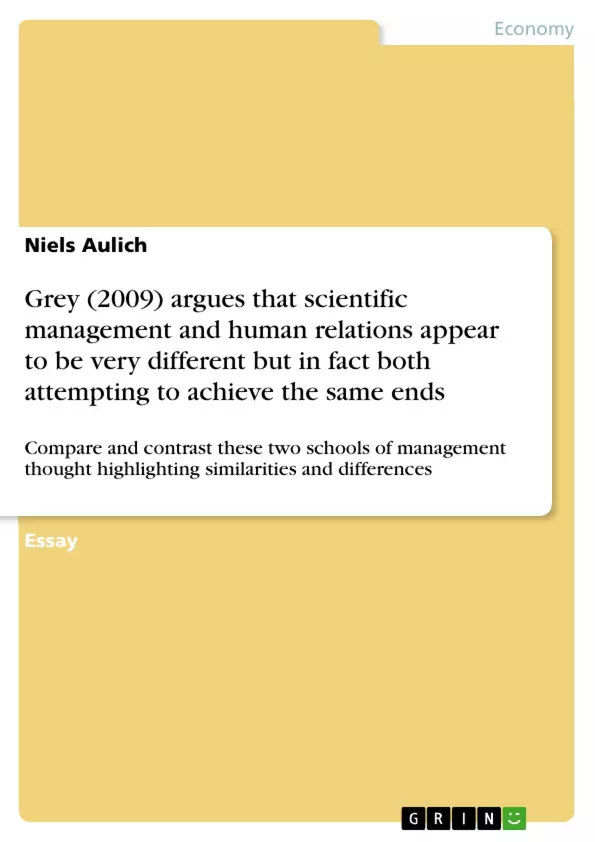The structure of this assignment refers mainly to the cornerstones of the organisational theory. It is unavoidable to start with a short overview of the bureaucracy theory and thus, to highlight SM and HRT as a basic management approach. Furthermore, this assignment will point out similarities and differences between both approaches. Finally, the conclusion summarises the main arguments and gives a firm stand about the above mentioned questions.
Inhaltsverzeichnis (Table of Contents)
- Introduction
- Main Body
- The Rise of Organisation Theory
- Scientific Management
- Human Relation Theory
- Two Approaches, One Goal? - Similarities and Differences
- Conclusion
Zielsetzung und Themenschwerpunkte (Objectives and Key Themes)
This essay aims to compare and contrast the theories of Scientific Management and Human Relations Theory, as outlined by Grey (2009). It examines the similarities and differences between these two schools of management thought, highlighting their shared objectives and distinct approaches to achieving them.
- The evolution and development of organizational theory
- The key principles and practices of Scientific Management
- The core tenets and applications of Human Relations Theory
- Commonalities and disparities between the two management approaches
- The continued relevance of these theories in contemporary business contexts
Zusammenfassung der Kapitel (Chapter Summaries)
The essay commences with an introduction that situates the discussion within the broader context of organizational theory. It highlights the importance of efficient management in achieving organizational success, particularly in light of global economic challenges. The introduction introduces the two central theories – Scientific Management (SM) and Human Relations Theory (HRT) – and outlines the essay's main objectives.
The 'Main Body' section delves into the historical development of organizational theory, tracing its roots back to the Industrial Revolution. The chapter emphasizes the significance of bureaucratic management as a foundational concept. It subsequently examines the rise of Scientific Management, highlighting the contributions of Frederick Winslow Taylor. This chapter concludes by summarizing Taylor's core ideas and their impact on contemporary business practices.
The chapter titled 'Human Relation Theory' is omitted to avoid spoilers and maintain suspense for the reader.
The 'Two Approaches, One Goal? - Similarities and Differences' chapter, also excluded for spoiler reasons, likely delves into the comparative analysis of Scientific Management and Human Relations Theory, exploring both their shared objectives and divergent methods.
The 'Conclusion' chapter, while not summarized, likely offers a synthesis of the main arguments, drawing upon the comparative analysis presented in previous chapters to provide a final assessment of the two management approaches.
Schlüsselwörter (Keywords)
The essay revolves around the core concepts of Scientific Management, Human Relations Theory, organizational theory, management thought, efficiency, productivity, similarities, differences, and business contexts. It draws upon prominent figures like Frederick Winslow Taylor, Max Weber, and the broader history of organizational theory to shed light on the evolution and relevance of these management approaches.
- Citar trabajo
- Niels Aulich (Autor), 2011, Grey (2009) argues that scientific management and human relations appear to be very different but in fact both attempting to achieve the same ends, Múnich, GRIN Verlag, https://www.grin.com/document/195050



